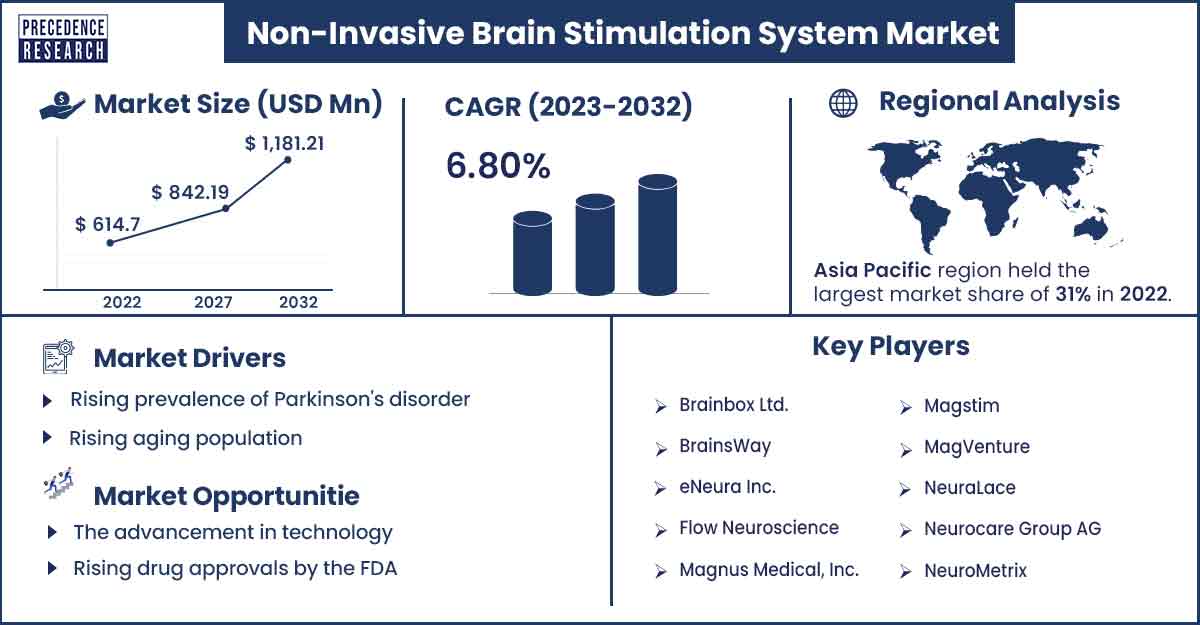November 2025
The global non-invasive brain stimulation system market revenue surpassed USD 653.43 million in 2023 and is projected to attain around USD 1,181.21 million by 2032, growing at a CAGR of 6.80% from 2023 to 2032.

Non-invasive brain stimulation refers to a set of technologies and techniques to stimulate or alter brain activity from the surface of the head without any introduction of instruments inside the body. NIBS is painless, safe, and has minimal side effects. This technique is widely used across the globe. It intends to improve quality of life by alleviating the impact of issues related to swallowing, speaking, movement, and other functions. These systems leverage advanced techniques, including transcranial electrical stimulation (tES) and transcranial magnetic stimulation (TMS), to alter brain functions for therapeutic and investigative purposes.
The growth of the global non-invasive brain stimulation system market is driven by healthcare infrastructure, supportive government initiatives, rising interest in neuroscience, growing demand for mental health treatments, advancement in technology, and rising investment in research and development activities. Moreover, In recent years, neurological conditions have become more prevalent, and the market is expected to grow as a result of the increasing cases of conditions such as depression, epilepsy, Parkinson's disease, chronic pain, and others.
North America is expected to dominate the market in the foreseeable future. This is driven by factors such as the presence of a well-established healthcare infrastructure, a rising focus on research and development activities, increasing healthcare expenditure, advancement of cutting-edge technologies, and rapid growth in neuroscience.
The United States market is experiencing robust growth in the region due to the increasing number of mental health treatments, rising adoption of the latest technology in the healthcare sector, and rising awareness regarding advanced therapies. Furthermore, the increasing prevalence of depression and Parkinson's disease creates the need for non-invasive brain stimulation, which results in accelerating the growth of the market.
The Parkinson's Foundation-backed study in 2022 found that almost 90,000 people are diagnosed with Parkinson's disease every year in the United States, nearly 1,000,000 people in the U.S. live with Parkinson's disease, and is expected to rise to 1.2 million by 2030.
| Report Coverage | Details |
| Market Revenue in 2023 | USD 653.43 Million |
| Projected Forecast Revenue by 2032 | USD 1,181.21 Million |
| Growth Rate from 2023 to 2032 | CAGR of 6.80% |
| Largest Market | Asia-Pacific |
| Base Year | 2022 |
| Forecast Period | 2023 to 2032 |
| Regions Covered | North America, Europe, Asia-Pacific, Latin America, and Middle East & Africa |
Drivers
Rising prevalence of Parkinson's disorder
The rising cases of Parkinson's disorder across the globe have led to the rising adoption of non-invasive brain stimulation procedures. Parkinson's disease is a multi-symptomatic neurodegenerative disorder that affects the neurological system, and it is one of the most common age-related health conditions. Death and disability due to Parkinson's disease are rising globally. According to the data published by Parkinson's Foundation in 2022, more than 10 million people worldwide are living with the condition.
Rising aging population
The rising geriatric population is more susceptible to Parkinson's disease as it occurs with increasing age. However, it also affects young people less than 50 years of age. The rising cases of age-related diseases have spurred the demand for non-invasive brain stimulation systems.
Restraint
Lack of awareness
The lack of proper awareness of non-invasive brain stimulation devices in developing and under-developing countries is projected to hamper the market's expansion. Limited technological penetration in such developing countries may adversely impact the healthcare infrastructure and is likely to limit the expansion of the industry. In addition, electroconvulsive therapy is gaining popularity rapidly, which acts as a major restraint concerning the non-invasive brain stimulation systems market.
Opportunities
Technological advancement
The advancement in technology is expected to offer a lucrative opportunity for the market. The non-invasive brain stimulation systems market is witnessing sophisticated healthcare infrastructure coupled with the advancement of cutting-edge technologies, which results in treatments for epilepsy, Parkinson's disease, stroke, depression, chronic pain, and other neurological disorders using TMS and TCS. Such advanced healthcare facilities offer effective treatment and are expected to contribute to the market's growth.
Rising drug approvals by the FDA
The increase in drug approvals by the U.S. Food and Drug Administration is expected to boost the market. Researchers are consistently working towards discovering advanced drugs to treat patients with Parkinson's disease to provide them with a healthy life.
Market Segmentation
By Product
By End-user
By Application
Buy this Research Report@ https://www.precedenceresearch.com/checkout/3367
You can place an order or ask any questions, please feel free to contact at sales@precedenceresearch.com | +1 650 460 3308
November 2025
July 2025
November 2025
April 2025